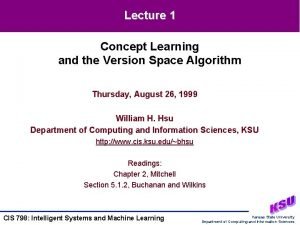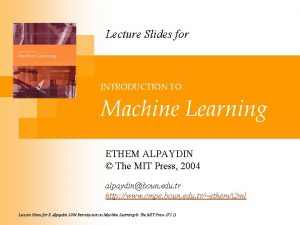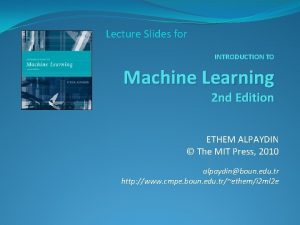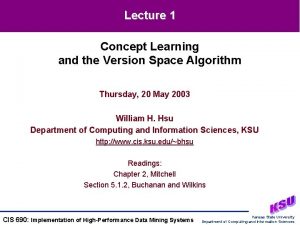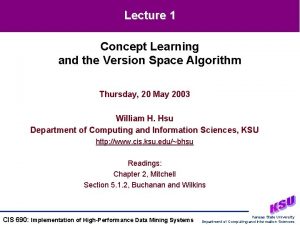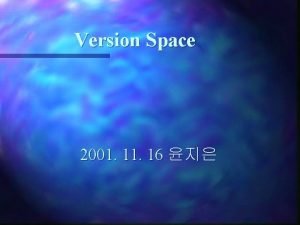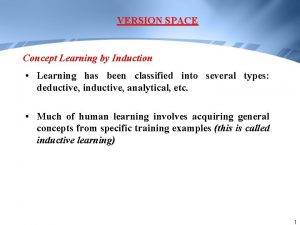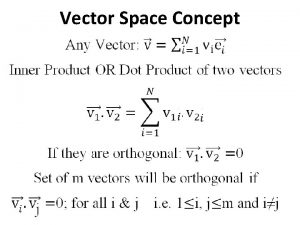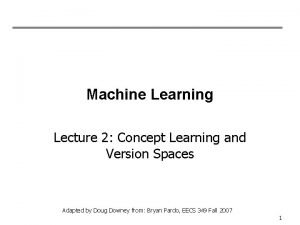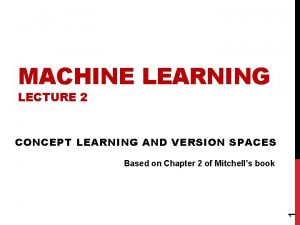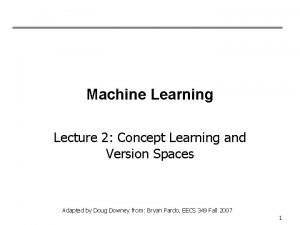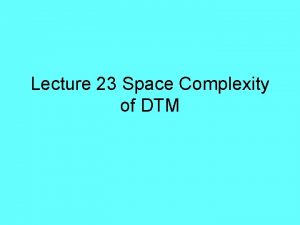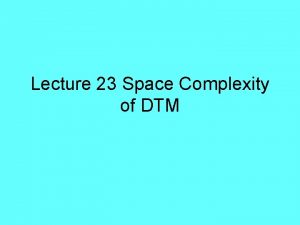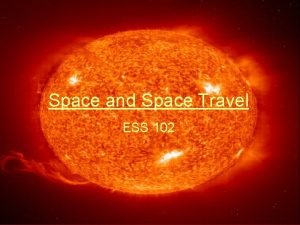Lecture 2 Concept Learning and the Version Space


















- Slides: 18

Lecture 2 Concept Learning and the Version Space Algorithm Wednesday, January 19, 2001 William H. Hsu Department of Computing and Information Sciences, KSU http: //www. cis. ksu. edu/~bhsu Readings: Chapter 2, Mitchell Section 5. 1. 2, Buchanan and Wilkins CIS 830: Advanced Topics in Artificial Intelligence Kansas State University Department of Computing and Information Sciences

Lecture Outline • Read: Chapter 2, Mitchell; Section 5. 1. 2, Buchanan and Wilkins • Suggested Exercises: 2. 2, 2. 3, 2. 4, 2. 6 • Taxonomy of Learning Systems • Learning from Examples – (Supervised) concept learning framework – Simple approach: assumes no noise; illustrates key concepts • General-to-Specific Ordering over Hypotheses – Version space: partially-ordered set (poset) formalism – Candidate elimination algorithm – Inductive learning • Choosing New Examples • Next Week – The need for inductive bias: 2. 7, Mitchell; 2. 4. 1 -2. 4. 3, Shavlik and Dietterich – Computational learning theory (COLT): Chapter 7, Mitchell – PAC learning formalism: 7. 2 -7. 4, Mitchell; 2. 4. 2, Shavlik and Dietterich CIS 830: Advanced Topics in Artificial Intelligence Kansas State University Department of Computing and Information Sciences

What to Learn? • Classification Functions – Learning hidden functions: estimating (“fitting”) parameters – Concept learning (e. g. , chair, face, game) – Diagnosis, prognosis: medical, risk assessment, fraud, mechanical systems • Models – Map (for navigation) – Distribution (query answering, aka QA) – Language model (e. g. , automaton/grammar) • Skills – Playing games – Planning – Reasoning (acquiring representation to use in reasoning) • Cluster Definitions for Pattern Recognition – Shapes of objects – Functional or taxonomic definition • Many Problems Can Be Reduced to Classification CIS 830: Advanced Topics in Artificial Intelligence Kansas State University Department of Computing and Information Sciences

How to Learn It? • Supervised – What is learned? Classification function; other models – Inputs and outputs? Learning: – How is it learned? Presentation of examples to learner (by teacher) • Unsupervised – Cluster definition, or vector quantization function (codebook) – Learning: – Formation, segmentation, labeling of clusters based on observations, metric • Reinforcement – Control policy (function from states of the world to actions) – Learning: – (Delayed) feedback of reward values to agent based on actions selected; model updated based on reward, (partially) observable state CIS 830: Advanced Topics in Artificial Intelligence Kansas State University Department of Computing and Information Sciences

(Supervised) Concept Learning • Given: Training Examples <x, f(x)> of Some Unknown Function f • Find: A Good Approximation to f • Examples (besides Concept Learning) – Disease diagnosis • x = properties of patient (medical history, symptoms, lab tests) • f = disease (or recommended therapy) – Risk assessment • x = properties of consumer, policyholder (demographics, accident history) • f = risk level (expected cost) – Automatic steering • x = bitmap picture of road surface in front of vehicle • f = degrees to turn the steering wheel – Part-of-speech tagging – Fraud/intrusion detection – Web log analysis – Multisensor integration and prediction CIS 830: Advanced Topics in Artificial Intelligence Kansas State University Department of Computing and Information Sciences

A Learning Problem x 1 x 2 x 3 x 4 • • Unknown Function y = f (x 1, x 2, x 3, x 4 ) xi: ti, y: t, f: (t 1 t 2 t 3 t 4) t Our learning function: Vector (t 1 t 2 t 3 t 4 t) (t 1 t 2 t 3 t 4) t CIS 830: Advanced Topics in Artificial Intelligence Kansas State University Department of Computing and Information Sciences

Hypothesis Space: Unrestricted Case • | A B | = | B | |A| • |H 4 H | = | {0, 1} {0, 1} | = 224 = 65536 function values • Complete Ignorance: Is Learning Possible? – Need to see every possible input/output pair – After 7 examples, still have 29 = 512 possibilities (out of 65536) for f CIS 830: Advanced Topics in Artificial Intelligence Kansas State University Department of Computing and Information Sciences

Training Examples for Concept Enjoy. Sport • Specification for Examples – Similar to a data type definition – 6 attributes: Sky, Temp, Humidity, Wind, Water, Forecast – Nominal-valued (symbolic) attributes - enumerative data type • Binary (Boolean-Valued or H -Valued) Concept • Supervised Learning Problem: Describe the General Concept CIS 830: Advanced Topics in Artificial Intelligence Kansas State University Department of Computing and Information Sciences

Representing Hypotheses • Many Possible Representations • Hypothesis h: Conjunction of Constraints on Attributes • Constraint Values – Specific value (e. g. , Water = Warm) – Don’t care (e. g. , “Water = ? ”) – No value allowed (e. g. , “Water = Ø”) • Example Hypothesis for Enjoy. Sport – Sky Air. Temp Humidity Wind <Sunny ? ? Strong Water ? Forecast Same> – Is this consistent with the training examples? – What are some hypotheses that are consistent with the examples? CIS 830: Advanced Topics in Artificial Intelligence Kansas State University Department of Computing and Information Sciences

Prototypical Concept Learning Tasks • Given – Instances X: possible days, each described by attributes Sky, Air. Temp, Humidity, Wind, Water, Forecast – Target function c Enjoy. Sport: X H {{Rainy, Sunny} {Warm, Cold} {Normal, High} {None, Mild, Strong} {Cool, Warm} {Same, Change}} {0, 1} – Hypotheses H: conjunctions of literals (e. g. , <? , Cold, High, ? , ? >) – Training examples D: positive and negative examples of the target function • Determine – Hypothesis h H such that h(x) = c(x) for all x D – Such h are consistent with the training data • Training Examples – Assumption: no missing X values – Noise in values of c (contradictory labels)? CIS 830: Advanced Topics in Artificial Intelligence Kansas State University Department of Computing and Information Sciences

The Inductive Learning Hypothesis • Fundamental Assumption of Inductive Learning • Informal Statement – Any hypothesis found to approximate the target function well over a sufficiently large set of training examples will also approximate the target function well over other unobserved examples – Definitions deferred: sufficiently large, approximate well, unobserved • Later: Formal Statements, Justification, Analysis – Chapters 5 -7, Mitchell: different operational definitions – Chapter 5: statistical – Chapter 6: probabilistic – Chapter 7: computational • Next: How to Find This Hypothesis? CIS 830: Advanced Topics in Artificial Intelligence Kansas State University Department of Computing and Information Sciences

Instances, Hypotheses, and the Partial Ordering Less-Specific-Than Instances X Hypotheses H Specific h 1 x 1 h 3 h 2 x 2 General x 1 = <Sunny, Warm, High, Strong, Cool, Same> x 2 = <Sunny, Warm, High, Light, Warm, Same> h 1 = <Sunny, ? , Strong, ? > h 2 = <Sunny, ? , ? , ? > h 3 = <Sunny, ? , ? , Cool, ? > P Less-Specific-Than More-General-Than h 2 P h 1 h 2 P h 3 CIS 830: Advanced Topics in Artificial Intelligence Kansas State University Department of Computing and Information Sciences

Find-S Algorithm 1. Initialize h to the most specific hypothesis in H H: the hypothesis space (partially ordered set under relation Less-Specific-Than) 2. For each positive training instance x For each attribute constraint ai in h IF the constraint ai in h is satisfied by x THEN do nothing ELSE replace ai in h by the next more general constraint that is satisfied by x 3. Output hypothesis h CIS 830: Advanced Topics in Artificial Intelligence Kansas State University Department of Computing and Information Sciences

Hypothesis Space Search by Find-S Instances X Hypotheses H x 3 - h 0 h 1 x 1+ h 2, 3 x 2+ x 4+ x 1 = <Sunny, Warm, Normal, Strong, Warm, Same>, + x 2 = <Sunny, Warm, High, Strong, Warm, Same>, + x 3 = <Rainy, Cold, High, Strong, Warm, Change>, x 4 = <Sunny, Warm, High, Strong, Cool, Change>, + • h 4 h 1 = <Ø, Ø, Ø, Ø> h 2 = <Sunny, Warm, Normal, Strong, Warm, Same> h 3 = <Sunny, Warm, ? , Strong, Warm, Same> h 4 = <Sunny, Warm, ? , Strong, Warm, Same> h 5 = <Sunny, Warm, ? , Strong, ? > Shortcomings of Find-S – Can’t tell whether it has learned concept – Can’t tell when training data inconsistent – Picks a maximally specific h (why? ) – Depending on H, there might be several! CIS 830: Advanced Topics in Artificial Intelligence Kansas State University Department of Computing and Information Sciences

Version Spaces • Definition: Consistent Hypotheses – A hypothesis h is consistent with a set of training examples D of target concept c if and only if h(x) = c(x) for each training example <x, c(x)> in D. – Consistent (h, D) • <x, c(x)> D. h(x) = c(x) Definition: Version Space – The version space VSH, D , with respect to hypothesis space H and training examples D, is the subset of hypotheses from H consistent with all training examples in D. – VSH, D { h H | Consistent (h, D) } CIS 830: Advanced Topics in Artificial Intelligence Kansas State University Department of Computing and Information Sciences

The List-Then-Eliminate Algorithm 1. Initialization: Version. Space a list containing every hypothesis in H 2. For each training example <x, c(x)> Remove from Version. Space any hypothesis h for which h(x) c(x) 3. Output the list of hypotheses in Version. Space S: <Sunny, ? , Strong, ? > G: <Sunny, Warm, ? , Strong, ? > <Sunny, Warm, ? , ? > <Sunny, ? , ? , ? > <? , Warm, ? , Strong, ? > <? , Warm, ? , ? > Example Version Space CIS 830: Advanced Topics in Artificial Intelligence Kansas State University Department of Computing and Information Sciences

Terminology • Supervised Learning – Concept - function from observations to categories (so far, boolean-valued: +/-) – Target (function) - true function f – Hypothesis - proposed function h believed to be similar to f – Hypothesis space - space of all hypotheses that can be generated by the learning system – Example - tuples of the form <x, f(x)> – Instance space (aka example space) - space of all possible examples – Classifier - discrete-valued function whose range is a set of class labels • Inductive Learning – Inductive generalization - process of generating hypotheses that describe cases not yet observed – The inductive learning hypothesis CIS 830: Advanced Topics in Artificial Intelligence Kansas State University Department of Computing and Information Sciences

Summary Points • Concept Learning as Search through H – Hypothesis space H as a state space – Learning: finding the correct hypothesis • General-to-Specific Ordering over H – Partially-ordered set: Less-Specific-Than (More-General-Than) relation – Upper and lower bounds in H • Learner Can Generate Useful Queries • Next Lecture: A Machine Learning Algorithm – Version space (candidate elimination) algorithm • Characterizng learner’s uncertainty • Predictions over previously unseen cases – When and why are inductive leaps possible? CIS 830: Advanced Topics in Artificial Intelligence Kansas State University Department of Computing and Information Sciences
 Hypothesis space in machine learning
Hypothesis space in machine learning 01:640:244 lecture notes - lecture 15: plat, idah, farad
01:640:244 lecture notes - lecture 15: plat, idah, farad Concept learning task in machine learning
Concept learning task in machine learning Cuadro comparativo de e-learning
Cuadro comparativo de e-learning Machine learning lecture slides
Machine learning lecture slides Ethem alpaydin
Ethem alpaydin Introduction to machine learning slides
Introduction to machine learning slides Joint space vs cartesian space
Joint space vs cartesian space Space junk the space age began
Space junk the space age began Camera space to world space
Camera space to world space Unscented trajectory chapter 5
Unscented trajectory chapter 5 World space computer
World space computer Apa yang dimaksud ruang lingkup seni
Apa yang dimaksud ruang lingkup seni Hình ảnh bộ gõ cơ thể búng tay
Hình ảnh bộ gõ cơ thể búng tay Ng-html
Ng-html Bổ thể
Bổ thể Tỉ lệ cơ thể trẻ em
Tỉ lệ cơ thể trẻ em Voi kéo gỗ như thế nào
Voi kéo gỗ như thế nào Tư thế worms-breton
Tư thế worms-breton
